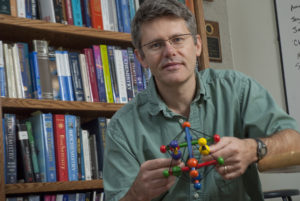
MSU photo by Kelly Gorham.
Driving has continued to be a source of pollution.
Trevor Douglas, professor of chemistry at Indiana University, discusses an enzyme that may help us power our cars on water and sunlight.
Trevor Douglas is the Earl Blough Professor of Chemistry in the IU Bloomington College of Arts and Sciences’ Department of Chemistry.
In his lab at IU, Douglas’s team has pioneered the use of viruses as a platform for the synthetic manipulation of molecules, with applications ranging from materials science to medicine. Recently, he served as the lead investigator on research reported in the journal Nature Chemistry that describes a new method to create a highly efficient biomaterial that catalyzes the formation of hydrogen — one half of the “holy grail” of splitting H2O to make hydrogen and oxygen for fueling cheap and efficient cars that run on water.
Prior to IU, Douglas was faculty member Montana State University. He holds a Ph.D. in inorganic chemistry from Cornell University and a bachelor’s degree in chemistry from the University of California at San Diego.
From 1992-1994, he also was a postdoctoral fellow at Bath University in the United Kingdom, where he worked in the area of biomineralization.
Hydrogen Biofuel
What if you could run your car on water and sunlight?
Plenty of car makers want to make that fantasy a reality with hydrogen cars, which combine hydrogen and oxygen in a fuel cell to power an electric motor.
But there are problems. The majority of hydrogen fuel is produced from natural gas. The rare metals used in fuel cells, like platinum, are non-renewable and often extracted from the Earth in an environmentally destructive – and expensive – way.
But our lab recently made a scientific breakthrough that‘s provides a possible alternative – one half of the “holy grail” of generating power from the hydrogen in water.
We’ve done this using a remarkable enzyme found in nature – hydrogenase — which both catalyzes the formation of hydrogen from water and also works in reverse, breaking the bonds in hydrogen and oxygen to release energy.
The hydrogenase enzyme is normally fragile and vulnerable to destruction by heat or chemicals in the environment, but we have encased it inside the protective shell, or “capsid,” of a virus which both stabilizes it and boosts the catalytic efficiency by 150-fold.
The hydrogenase is produced by two genes from a common bacterium, E. coli. The capsid that protects these gene products comes from a bacterial virus called bacteriophage P22. We dubbed the resulting biomaterial “P22-Hyd.”
This new material isn’t only more efficient than the unaltered enzyme but is also easy to produce. No complex, multi-step chemical synthesis needed. It’s basic fermentation. We simply “grow the bug” and let the biology do the work for us.
Of course, the other half of our ultimate target remains elusive: the synthesis of hydrogen using sunlight as the energy source. Right now, we can’t “start the engine” without using unwieldly lab methods for driving the synthesis of hydrogen. But we’re working.
If we can incorporate this new material into a solar-powered system, our wheels might never stop turning.


Comments
One response to “Trevor Douglas, Indiana University – Hydrogen Biofuel”
Don’t you think we should be spending our tax dollars on more significant–and realistic solutions. Anyone familiar with the field knows this is, for lack of better words, wasteful and fruitless. Efficiency of 150-fold is really means nothing. Enzymes have a very finite, and limited lifetime, meaning the real “efficiency” here is ashamedly low.
Blake Wiedenheft -MSU Assistant Professor of Microbiology and Immunology